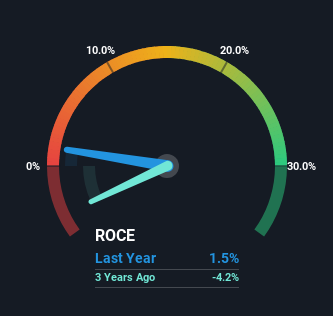Returns At Elgi Rubber (NSE:ELGIRUBCO) Are On The Way Up
Finding a business that has the potential to grow substantially is not easy, but it is possible if we look at a few key financial metrics. Typically, we'll want to notice a trend of growing return on capital employed (ROCE) and alongside that, an expanding base of capital employed. If you see this, it typically means it's a company with a great business model and plenty of profitable reinvestment opportunities. So when we looked at Elgi Rubber (NSE:ELGIRUBCO) and its trend of ROCE, we really liked what we saw.
Our free stock report includes 3 warning signs investors should be aware of before investing in Elgi Rubber. Read for free now.Return On Capital Employed (ROCE): What Is It?
For those who don't know, ROCE is a measure of a company's yearly pre-tax profit (its return), relative to the capital employed in the business. The formula for this calculation on Elgi Rubber is:
Return on Capital Employed = Earnings Before Interest and Tax (EBIT) ÷ (Total Assets - Current Liabilities)
0.015 = ₹46m ÷ (₹5.3b - ₹2.3b) (Based on the trailing twelve months to December 2024).
Thus, Elgi Rubber has an ROCE of 1.5%. Ultimately, that's a low return and it under-performs the Machinery industry average of 16%.
See our latest analysis for Elgi Rubber

Historical performance is a great place to start when researching a stock so above you can see the gauge for Elgi Rubber's ROCE against it's prior returns. If you'd like to look at how Elgi Rubber has performed in the past in other metrics, you can view this free graph of Elgi Rubber's past earnings, revenue and cash flow.
The Trend Of ROCE
Shareholders will be relieved that Elgi Rubber has broken into profitability. The company was generating losses five years ago, but has managed to turn it around and as we saw earlier is now earning 1.5%, which is always encouraging. On top of that, what's interesting is that the amount of capital being employed has remained steady, so the business hasn't needed to put any additional money to work to generate these higher returns. That being said, while an increase in efficiency is no doubt appealing, it'd be helpful to know if the company does have any investment plans going forward. Because in the end, a business can only get so efficient.
On a separate but related note, it's important to know that Elgi Rubber has a current liabilities to total assets ratio of 43%, which we'd consider pretty high. This can bring about some risks because the company is basically operating with a rather large reliance on its suppliers or other sorts of short-term creditors. Ideally we'd like to see this reduce as that would mean fewer obligations bearing risks.
What We Can Learn From Elgi Rubber's ROCE
To sum it up, Elgi Rubber is collecting higher returns from the same amount of capital, and that's impressive. And a remarkable 394% total return over the last five years tells us that investors are expecting more good things to come in the future. Therefore, we think it would be worth your time to check if these trends are going to continue.
One more thing: We've identified 3 warning signs with Elgi Rubber (at least 1 which is significant) , and understanding them would certainly be useful.
While Elgi Rubber isn't earning the highest return, check out this free list of companies that are earning high returns on equity with solid balance sheets.
Valuation is complex, but we're here to simplify it.
Discover if Elgi Rubber might be undervalued or overvalued with our detailed analysis, featuring fair value estimates, potential risks, dividends, insider trades, and its financial condition.
Access Free AnalysisHave feedback on this article? Concerned about the content? Get in touch with us directly. Alternatively, email editorial-team (at) simplywallst.com.
This article by Simply Wall St is general in nature. We provide commentary based on historical data and analyst forecasts only using an unbiased methodology and our articles are not intended to be financial advice. It does not constitute a recommendation to buy or sell any stock, and does not take account of your objectives, or your financial situation. We aim to bring you long-term focused analysis driven by fundamental data. Note that our analysis may not factor in the latest price-sensitive company announcements or qualitative material. Simply Wall St has no position in any stocks mentioned.
About NSEI:ELGIRUBCO
Elgi Rubber
Manufactures and sells reclaimed rubber, retreading machinery, and retread rubber in India and internationally.
Slightly overvalued with imperfect balance sheet.
Similar Companies
Market Insights
Community Narratives



